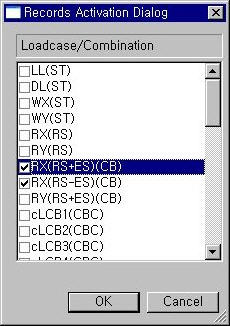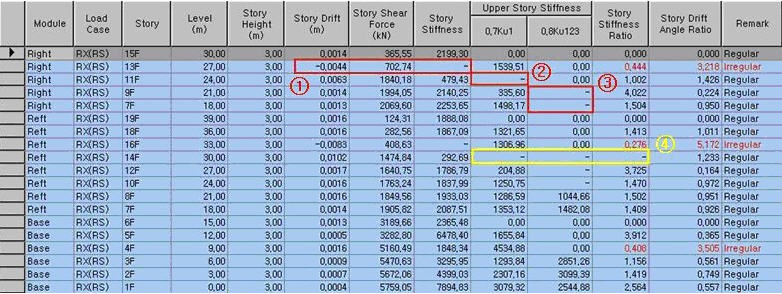Stiffness Irregularity Check (Soft Story Check) Table
| ||||||||
|
| ||||||||
|
| ||||||||
|
Story Stiffness Ratio of a building structure is tabulated in the Stiffness Irregularity Check (Soft Story Check) Table.
When “Consider Story Module” under "Story Shear Force Ratio" is checked in the “Model/Building/Control Data", accurate shear forces can be obtained for the story overlapping the upper Module and the lower Module.
When Modules are defined in Results > Result Tables > Story > Define Module, the Module data is displayed in the first column of the table.
When the ratios exceed the allowable limit, they appear in red and “Irregular” is printed in the Remark.
"Story Shear Force Ratio" in "Model/Building/Control Data" must be checked for this function, which is checked as the Default.
Table Tool in MIDAS/Gen offers a variety of powerful built-in functions.
Refer to the following items for detail directions: Usage of Table Tool
Terminology
Familiarize with Usage
Basic directions (Cell motion, selection, size control, etc.)
Data manipulation (Add, delete, modify data, etc.)
Copy/Paste data using clipboard
Supplementary Table functions
Table Sorting
Table format setting
Auto-fit column width
Graph printing
Supplementary functions by Table types
Node/Element Table
Results Table | ||||||||
|
| ||||||||
|
| ||||||||
|
| ||||||||
|
From the Main Menu select Results > Result Tables > Story > Stiffness Irregularity Check (Soft Story Check)
Select Result Tables > Story > Stiffness Irregularity Check (Soft Story Check) in the Tables tab of the Tree Menu. | ||||||||
|
| ||||||||
|
| ||||||||
|
Select load cases/combinations for which Stiffness Irregularity Check is required and the Story Drift calculation method.
Record Activation dialog box
Context Menu (Stiffness Irregularity Parameters)
Story Drift Method (Stiffness Irregularity Parameters)
1. Drift at the Center of Mass
Difference in lateral displacements at the centers of masses of two consecutive stories
Drift Factor (Maximum / Current): Maximum story displacement / Average story drift
2. Maximum Drift of Outer Extreme Points
Maximum story drift among the story drifts at all the outer extreme corner nodes to which vertical elements connect.
3. Maximum Drift of All Vertical Elements
Maximum story drift among the story drifts at all nodes to which vertical elements connect.
Story Stiffness Method (SEAOC, GB50011-2001)
1. 1/Story Drift Ratio (SEAOC)
Display the story stiffness as an inverse number of story drift ratio.
2. Story Shear/Story Drift (GB50011-2001)
Display the story stiffness as a ratio of story shear to story drift.
Refer to Usage of Table Tool and check the following data:
When Modules are not defined
Load Case: Load case/Combination
Story: Story number
Level: Story Elevation
Height: Story Height
1. Story Drift
Story drift for the selected Load Case
2. Story Shear Force
Story shear force due to the selected Load Case
3. Story Stiffness
Story Stiffness = Story Shear / Story Drift
4. Upper Story Stiffness
0.7 Ku1: 70% of the Story Stiffness at the story immediately above the current story
0.8 Ku123: 80% of the average Story Stiffness of the three consecutive stories immediately above the current story
5. Story Stiffness Ratio
Story Stiffness Ratio = Story Stiffness of the current story / Max (0.7 Ku1, 0.8 Ku123)
Story Stiffness Ratio for the Roof (top story) is not computed. Also, if three stories above the current story do not exist, only 0.7 Ku1 value is computed.
6. Story Drift Angle Ratio
Story Drift Angle Ratio: Story drift angle of the current story is divided by that of the upper story
7. Remark
If the "Story Drift Angle Ratio" exceeds 1.0 and 'Story Stiffness Ratio' exceeds 1.3, "Irregular" is printed, otherwise "Regular" is printed.
Note1
Table is generated as per the following rules:
1. If Story Drift is negative, the corresponding Story Stiffness is displayed with “-“ sign (ич). 2. If the Story Stiffness of an upper floor is displayed with “-“ sign then 0.7Ku1 is also displayed with “-“ sign (иш). 3. If one of the Stiffnesses of the three upper floors is displayed with “-“ sign then 0.8Ku123 is also displayed with “-“ sign (ищ). 4. If both 0.7Ku1and 0.8Ku123 are displayed with “-“ sign then Story Stiffness Ratio is also displayed with “-“ sign.
When Modules are defined
The Module column is generated only when the Modules are defined. Results of evaluation of stiffness irregularity are calculated as per the following Note.
Note 2. Since the “Upper Story Stiffness” is zero for the story immediately below the top floor of upper Modules, it is always marked as ‘Regular’. 3. As per the evaluation method for stiffness using 0.7Ku1, the “Upper Story Stiffness” is always displayed as ‘0’ for the story immediately below the top floor of each Module. 4. As per the evaluation method for stiffness using 0.8Ku123, “Upper Story Stiffness” is always displayed as ‘0’ for the three stories immediately below the top floor of each Module.
Module: Module name is defined in Define Module
Load Case: Load case/Combination
Story: Story number
Level: Story Elevation
Height: Story Height
1. Story Drift
Story drift for the selected Load Case
2. Story Shear Force
Story shear force due to the selected Load Case
3. Story Stiffness
Story Stiffness = Story Shear / Story Drift
4. Upper Story Stiffness
0.7 Ku1: 70% of the Story Stiffness at the story immediately above the current story
0.8 Ku123: 80% of the average Story Stiffness of the three consecutive stories immediately above the current story
5. Story Stiffness Ratio
Story Stiffness Ratio = Max (0.7 Ku1, 0.8 Ku123) / Story Stiffness of the current story
Story Stiffness Ratio for the Roof (top story) is not computed. Also, if no three stories exist above the current story, only 0.7 Ku1 value is computed.
6. Story Drift Angle Ratio
Story Drift Angle Ratio: Story drift angle of the current story is divided by that of the upper story
7. Remark
If "Story Drift Angle Ratio" exceeds 1.0 and 'Story Stiffness Ratio' exceeds 1.3, "Irregular" is printed, otherwise "Regular" is printed.
Note1 Table is generated as per the following rules: 1. If Story Drift is negative, the corresponding Story Stiffness is displayed with “-“ sign (ич). 2. If the Story Stiffness of an upper floor is with “-“ sign then 0.7Ku1 is also displayed with “-“ sign (иш). 3. If one of the Stiffnesses of the three upper floors is with “-“ sign then 0.8Ku123 is displayed with “-“ sign (ищ). 4. If both 0.7Ku1and 0.8Ku123 are with “-“ sign then Story Stiffness Ratio is displayed with “-“ sign.
Note2 1) Load Case = EX, Story = 5F
Max (0.7 X 6F, 0.8 X (6F + 7F + 8F) / 3) = 11198.43 10011.2 / 11198.43 = 0.893 < 1 2) Load Case = EY, Story = 5F
Max (0.7 X 6F, 0.8 X (6F + 7F + 8F) / 3) = 7624.96 7937.8 / 7624.96 = 1.04 >1
| ||||||||
|
|



